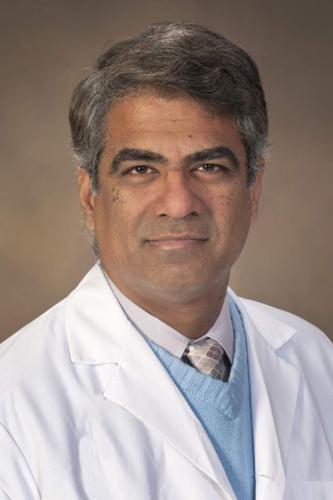Arizona residents continue to experience long COVID-19 at a higher rate than the national rate, according to the most recent data from the U.S. Centers for Disease Control and Prevention.
People with long COVID can have a wide range of symptoms that can last for weeks, months or even years after infection, and can go away and come back again, the CDC says.
The above-average rate here makes sense, given Arizona’s demographics of COVID transmission and vaccination, said Dr. Sairam Parthasarathy, a principal investigator for the Arizona cohort of a recent study on long COVID and chief of the Division of Pulmonary, Allergy, Critical Care and Sleep Medicine at the University of Arizona College of Medicine.
The most recent CDC data shows the national rate of people who have experienced long COVID is 15.1%, Parthasarathy said. But for Arizona residents, the number is 18.5%.
“Arizona had the unfortunate distinction of having one of the highest acute COVID rates and acute (severe) COVID translates into long COVID,” Parthasarathy said in an interview Tuesday. “More people who are sicker translates to more people with long COVID.”
“The reason for the severe cases is that our vaccination rates were lagging behind national average at one point in time,” he said.
The vaccination rate for older adults in Arizona was more in line with the national average, which has translated to fewer older adults suffering from long COVID, since they were vaccinated and protected earlier than the rest of the population, Parthasarathy said.
“At this point in time, when you look at the snapshot of who has long COVID, strangely, it’s the younger people with more long COVID,” he said. “With youth comes a sense of invincibility. So they are less likely to get vaccinated and when they get the infection, they’re more likely to develop long COVID.”
People of color are also affected by long COVID at a higher rate than non-Hispanic white people, Parthasarathy said, in part because of employment trends.
People who worked in public transportation, restaurants, public sanitation, hotels, grocery stores and other industries were exposed to COVID-19 before the vaccine became available and were infected at a higher rate. Because many of these jobs are filled by people of color, this has translated to a higher rate of long COVID, Parthasarathy said.
The long COVID rate for Hispanic patients is 2.5% above the national average in the most recent CDC data.

Dr. Sairam Parthasarathy
Parthasarathy said keeping up to date on boosters is an effective way to avoid infection and a subsequent case of long COVID. While 80% of the U.S. population received the primary series of COVID vaccinations, only 17% have gotten boosters, he said.
“There 63% of people who originally got vaccinated who have not gone and gotten up-to-date with booster vaccines,” Parthasarathy said. “We need to be wise and recognize that this is something that’s preventable. But if you unfortunately end up getting the infection, then we have to do the best we can to minimize the risk of developing long COVID.”
Arizona part of study
Arizona is one of 15 sites participating in a four-year COVID study funded by the National Institutes of Health. Initial findings, showing long COVID was more common and severe in study participants infected before the 2021 Omicron variant, were recently published in the Journal of American Medicine.
The study is part of a nationwide effort to understand why some people develop long-term symptoms following COVID-19 and how to detect, treat and prevent long COVID.
The study included nearly 10,000 participants, many of whom had COVID-19, and uncovered new details about long COVID, a set of post-infection conditions that can affect almost every organ or tissue in the body, the UA says.
Researchers with UA Health Sciences are leading one of the 15 adult cohorts contributing to the research and say the study is an important first glimpse into the complexities of long COVID.
12 distinguishing symptoms
Researchers examined data from 9,764 adults, including 8,646 who had COVID-19. They assessed more than 30 symptoms across body areas and organs and identified 12 symptoms that most set apart people with and without long COVID.
The symptoms include post-exertional malaise, fatigue, brain fog, dizziness, gastrointestinal symptoms, heart palpitations, issues with sexual desire or capacity, loss of smell or taste, thirst, chronic cough, chest pain and abnormal movements.
Parthasarathy said it’s important to understand that these 12 symptoms are not necessarily the most common or severe, but rather the most distinguishing. Just because a study participant didn’t end up in the group with the distinguishing symptoms of long COVID, it doesn’t mean they didn’t or don’t have long COVID, but rather that their symptoms are more common among the general population, he said.
“The idea is for us to look more deeply at these people with these (distinguishing) symptoms and find those people that are missing in the other group,” Parthasarathy said. “There are people with long COVID that did not make the threshold or the cut … and we did not put into that distinguished group. That does not mean they don’t have long COVID. They could be hiding in there and our job is to go find them.”
Parthasarathy cautioned that researchers were not recruiting for the study and participants self-selected to be involved, meaning that people who suspected they had long COVID were more likely to sign up. It’s important that researchers continue to collect information from people who were not infected with COVID-19 at all or were infected but did not develop long COVID, he said.
‘Phenomenal endeavor’
He said that while this major study is an important first step, there’s plenty of work to be done when it comes to diagnosing and treating long COVID.
“Long COVID is essentially all the damage that’s happened once that infection has happened. We need to make the body heal,” Parthasarathy said.
Figuring out how to help the body recover from long COVID will require extensive understanding of the severity of organ damage, effects to the immune system and more, but the researchers are up to the challenge, Parthasarathy said.
He said the convergence of experts in so many different fields of medicine is unprecedented, with every type of specialist working together to understand the disease. The first meeting he sat in on for the study had more than 300 participants and there are hundreds of organizations participating.
“This is a phenomenal endeavor, and saying phenomenal not with hubris, but with more of a sense that it requires patience,” he said. “It’s like a tanker. It moves, but it moves deliberately, but gosh, once it starts moving, nothing’s going to stop it.”
For millions of Americans, COVID-19 is still a part of their lives.





